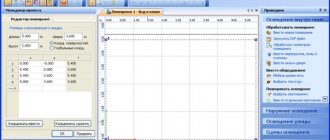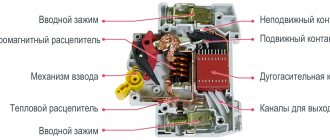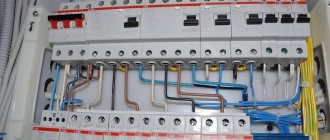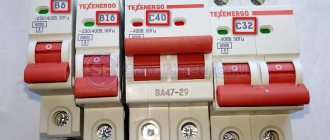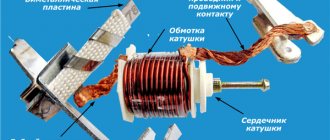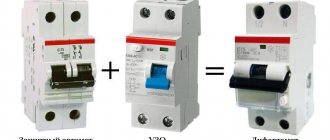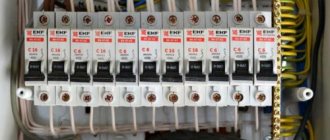Sections of the article:
How many kilowatts can a machine withstand 16, 25, 32 and 40 Amps?
When installing electrical wiring or connecting devices that run on electricity, it is very important to know which wire to run. It is equally important to understand how strong the machine must be in this case for the protection to actually work and protect the electrical wiring.
If the machine has a higher rating than necessary, and the cross-section of the conductors is smaller, then all this will lead to a short circuit due to overloads. How many kilowatts can a 16, 25, 32 or 40 Ampere machine withstand? What do you need to know when calculating loads on circuit breakers?
Which machine is suitable for 15 kW
The purpose of a three-phase machine is protection against overloads.
The purpose of a 3-phase machine is protection against overcurrents and overloads. The 15 kW modification operates on a network with a voltage of 380 V, that is, you will need a 25 A device for input. When choosing, you need to take into account that in conditions of short circuits, the current strength increases and can cause a fire in the electrical wiring.
When selecting a 15 kW machine model for a three-phase load, you will need to take into account the parameters of the permissible voltage and current during a short circuit. It is worth focusing on the calculated current indicators of the cable with the minimum cross-section that protects the switch and the rated current of the receiver.
When calculating the input switching machine according to power parameters in a 380 V network, the following are taken into account:
- electrical power – actual and additional;
- cable loading intensity;
- availability of free capacity in the design indicator of a residential building;
- remoteness of outbuildings and non-residential premises from the cable entry point.
Cost of a 25A 380V machine
In a 15 kilowatt network with additional power, an ASU device is installed.
Technical characteristics and markings of a 32 amp circuit breaker
The C32 circuit breaker is a circuit breaker that protects the network from overloads and short circuits. Also designed to manually turn on and off load currents. The machine is modular, because consist of separate single-pole blocks that can be used as single-phase or combined into two- or three-phase. This design makes it easy to assemble the required device of the required configuration. In case of breakdown, you can replace the individual damaged element.
Functions of three-phase machines
A three-phase switch simultaneously serves several single-phase zones of the circuit.
Before choosing an automatic switch, you should understand its functionality. Users are often mistaken into thinking that the device protects household appliances. The machine does not respond to its electrical indicators, only triggering in the event of a short circuit or overload. The three-phase functions include:
- simultaneous maintenance of several single-phase circuit zones;
- preventing the formation of overcurrents on the line;
- joint work with AC rectifiers;
- protection of high-power equipment;
- increased power due to the installation of a special converter;
- fast response in short circuit mode on a line with a large number of consumers;
- the ability to turn off manually using a switch or switch;
- Compatible with optional safety terminals.
Without a automatic device, the risk of cable fire increases.
Manufacturing companies
The modular automatic machine from foreign brands of the household series meets the standards for automatic machines in everyday life. But industrial ones are of better quality, more reliable and easier to install. The most famous include:
- foreign - ABB, Schneider Electric, Legrand;
- Russian - KEAZ, IEK, EKF.
Modular devices from domestic companies are made in China, although this is not a sign of their unreliability. The quality is slightly worse than household series from foreign manufacturers. They cost less. Also meets the standards for household machines. Usually they do not have series similar to industrial complexes of foreign companies.
Operating principle and purpose of the circuit breaker
Characteristics of the circuit breaker
The three-phase circuit breaker is activated by an electromagnetic switch in case of line fault. The principle of operation of the element is to heat the bimetallic plate at the moment the current rating increases and the voltage is turned off.
The fuse prevents short circuits and overcurrents with values higher than the calculated values from affecting the wiring. Without it, the cable cores heat up to the melting point, which leads to the ignition of the insulating layer. For this reason, it is important to know whether the network can handle the voltage.
Correspondence of wires to load
The problem is typical for old buildings, in which new machines, a meter, and an RCD are installed on the existing line.
The machines are selected according to the overall power of the equipment, but sometimes they do not work - the cable smokes or burns. For example, the cores of an old cable with a cross-section of 1.5 mm2 have a current limit of 19 A. If equipment with a total current of 22.7 A is turned on at a time, only a 25 Ampere modification will provide protection.
The wires will heat up, but the switch will remain turned on until the insulation melts. A fire can be prevented by completely replacing the wiring with a copper cable with a cross-section of 2.5 mm2.
Protecting the weakest section of cable wiring
Based on clause 3.1.4 of the PUE, the task of the automatic device is to prevent overload on the weakest link of the electrical circuit. Its rated current is selected based on the current of the connected household appliances.
If the machine is selected incorrectly, the unprotected area will cause a fire.
Purpose
A 25 ampere circuit breaker is a device whose main task is to ensure the safety of the electrical network from overcurrent, that is, from a short circuit with overload. The main purpose of the device is to ensure the safety of the user himself when using the network and electrical appliances.
Such equipment is turned on and off from an electrical circuit. It is most often used to protect an electric stove or other kitchen heating appliances.
Note! It can also be used to protect lighting system, motor, transformer and electronic appliance.
Principles for calculating the machine according to the cable cross-section
Calculations for a 3-phase automatic circuit breaker are carried out based on the cable cross-section. For a 25 A model, you will need to refer to the table.
| Wire cross-section, mm2 | Permissible load current based on cable material | |
| Copper | Aluminum | |
| 0,75 | 11 | 8 |
| 1 | 15 | 11 |
| 1,5 | 17 | 13 |
| 2,5 | 25 | 19 |
| 4 | 35 | 28 |
The 25 Ampere modification can be used to protect wiring or installed at the input.
For example, a copper wire with a cross-section of 1.5 mm2 with a permissible load current of 19 A is used for wiring. To prevent the cable from heating up, you will need to select a lower value - 16 A.
Cost of 16A machines
Determination of the dependence of power on the cross section using the formula
Table for selecting cable cross-section depending on power
If the cable cross-section is unknown, you can use the formula:
Icalc=P/Unom, where:
- Icalc – calculated current,
- P – power of devices,
- Unom – voltage rating.
As an example, we can calculate the machine that will need to be installed on a boiler with a load of 3 kW and a network voltage of 220 V:
- Convert 3 kW to Watts – 3x1000=3000.
- Divide the value by the voltage: 3000/220=13.636.
- Round the calculated current to 14 A.
Depending on the environmental conditions and the method of laying the cable, you need to take into account the correction factor for the 220 V network. The average value is 5 A. It will need to be added to the calculated current indicator Icalc = 14 +5 = 19 A. Next, the cross-section of the copper wire is selected from the PUE table.
| Section, mm2 | Load current, A | |||||
| Single core cable | Two-core cable | Three-core cable | ||||
| Single wire | 2 wires together | 3 wires together | 4 wires together | Single installation | Single installation | |
| 1 | 17 | 16 | 15 | 14 | 15 | 14 |
| 1,5 | 23 | 19 | 17 | 16 | 18 | 15 |
| 2,5 | 30 | 27 | 25 | 25 | 25 | 21 |
| 4 | 41 | 38 | 35 | 30 | 32 | 27 |
| 6 | 50 | 46 | 42 | 40 | 40 | 34 |
To summarize how to convert Amps to Kilowatts
Our article turned out to be not as short as many would like. Perhaps someone will even be able to reproach us, saying that it was necessary not to procrastinate, but to immediately say how to convert Amperes to Kilowatts and that’s the end of the matter. In our justification and response, we can only appeal to what we wanted best, that is, to convey to the reader the whole essence of the ongoing processes, and therefore an understanding of what and where it comes from. In this case, if you understand everything, then you will never have to return to our article, because what you understand remains with you forever!
Selection of automatic switch by power
Table of power of electrical appliances in the kitchen
Calculating the total power of household appliances will help you choose a safety switch. You will need to look at the value in the device passport. For example, in the kitchen the following are plugged into the socket:
- coffee maker – 1000 W;
- electric oven – 2000 W;
- microwave oven – 2000 W;
- electric kettle – 1000 W;
- refrigerator – 500 W.
Summing up the indicators, we get 6500 W or 6.5 kilowatts. Next, you will need to refer to the table of machines depending on the connection power.
| Single-phase connection 220 V | Three-phase connection | Machine power | |
| Delta circuit 380 V | Star circuit, 220 V | ||
| 3.5 kW | 18.2 kW | 10.6 kW | 16 A |
| 4.4 kW | 22.8 kW | 13.2 kW | 20 A |
| 5.5 kW | 28.5 kW | 16.5 kW | 25 A |
| 7 kW | 36.5 kW | 21.1 kW | 32 A |
| 8.8 kW | 45.6 kW | 26.4 kW | 40 A |
Based on the standard voltage wiring table, you can select a 32 A device that is suitable for a total power of 7 kW.
Cost of a 32A machine
If you plan to connect additional equipment, an increase factor is used. The average value of 1.5 is multiplied by the power obtained from the calculations. A reduction factor is applied if it is impossible to operate several electrical appliances at the same time. It is equal to 1 or minus 1.
Selecting a machine depending on the load power
For apartments and houses with new electrical wiring, the choice of machine is made based on the calculated load current.
A three-phase type device can be calculated by the rated load current or by the response speed in conditions of exceeding the current value. For calculations, you need to add up the power of all consumers and calculate the current passing through the line. Work is performed according to the formula:
I=P/U, where:
- P is the total power of all household appliances;
- U is the network voltage.
For example, the power is 7.2 kW, calculated using the formula 7200/220 = 32.72 A. The table shows ratings of 16, 20, 32, 25 and 40 A. The value is 32.72 A, taking into account the operation of the device at a value of 1 ,13 times more than the nominal value, multiply: 32x1.13=36.1 A. The table shows that it is better to install a 40 A model.
Methods for selecting a difavtomat
Rating of the difavtomat and its time-current characteristics
For example, consider a kitchen where a large amount of equipment is connected. First, you need to set the total power rating for a room with a refrigerator (500 W), microwave (1000 W), kettle (1500 W) and hood (100 W). The total power indicator is 3.1 kW. Based on it, various methods are used to select a 3-phase machine.
Table method
Based on the device table, a single-phase or three-phase device is selected based on the connection power. But the value in the calculations may not coincide with the tabular data. For a 3.1 kW network section, you will need a 16 A model - the closest value is 3.5 kW.
Graphical method
The selection technology is no different from the tabular one - you will need to find a schedule on the Internet. In the figure, the switches with their current load are shown horizontally, and the power consumption in one section of the circuit is shown vertically.
To establish the power of the device, you will need to draw a line horizontally to the point with the rated current. A total network load of 3.1 kW corresponds to a 16 A switch.
Criteria for selecting a three-phase switch
Before purchasing, it is worth considering all the parameters that the input device will have.
Phase and voltage
Single-phase 220 V models are connected to one terminal, three-phase 380 V models are connected to three.
Leakage current
The body is marked with the Greek letter “delta”. The current leakage of a private house is about 350 mA, of a separate group of devices - 30 mA, lamps and sockets - 30 mA, single links - 15 mA, boiler - 10 mA.
Varieties by current
The machine has indexes A (triggered by DC leakage) and AC (triggered by AC leakage).
Number of poles
A single-pole circuit breaker is used for one phase.
Depending on the number of poles, you can purchase a three-phase switch:
- single-pole type of devices for protecting one cable and one phase;
- two-pole, represented by two devices with a common switch - switching off occurs when the permissible value of one of them is exceeded, at the same time the neutral and phase in a single-phase network are cut off;
- a three-pole device that provides interruption and protection of the phase circuit - they are three devices with a common activation/deactivation handle;
- a four-pole device, which is mounted only on the input of a three-phase switchgear, breaks all three phases and the working zero. Breaking the grounding of the protection is unacceptable.
Regardless of the number of poles, the device shutdown time should not exceed 0.3 seconds.
Installation location
For domestic use, a 3-phase electric circuit breaker marked C is intended for 25 A. In this case, it is better to install products C50, C65, C85, C95 at the input. For sockets or other points - C 25 and C 15, for lighting - C 12 or C 17, for an electric stove - C 40. They will operate when the current readings are 5-10 times higher than the nominal value.
Connection diagram
Connection diagram without grounding
According to the PUE, the supply conductor is connected to a fixed microcontact. This means connecting from above (there may be exceptions). You need to look at the connection diagram located on the device body. The designations are as follows:
- symbol 1 in the diagram shows where the input of the first phase conductor is connected;
- 2 - shows the output of the first phase conductor;
- 3 – entrance;
- 4 – output for a two-pole device;
- 5 – entrance;
- 6 – three-pole output;
- 7 – entrance;
- 8 – four-pole output.
If, in addition to the numbers on the diagram and contacts, there is a designation of the letter N , the neutral conductor is connected here. When there is no such symbol, zero is connected to the terminals indicated by the maximum numbers. If the phase conductors are connected from above, then so is the zero. If the phase conductors are connected from below, the neutral one is also connected from below.
The c16 automatic machine is very rarely used in everyday life as an introductory one. There are similar requirements from electricity supply companies. When connecting, it is impossible to maintain selectivity even with respect to the thermal release, which means that in any emergency the input circuit breaker will be turned off or both at once.
Nuances to consider
Table of power consumption of various electrical appliances,
no one can know exactly what household appliances will be in a house or apartment. For this reason you should:
- increase the total calculated power of a three-phase automatic circuit breaker by 50%, or apply an increase factor of 1.5;
- a reduction factor is taken into account when there are not enough sockets in the room to simultaneously connect equipment;
- to simplify calculations, the load should be divided into groups;
- powerful devices should be connected separately, taking into account the low-power load;
- to calculate a low-power load, you will need to divide the power by the voltage;
- wiring is the main factor that is taken into account when choosing a 3-phase automatic switch; old aluminum wires can withstand 10 A, but if taken for 16 A sockets, they can melt;
- in domestic conditions, models with current ratings of 6, 16, 25, 32 and 40 A are most often used.
When purchasing a three-phase differential circuit breaker, you need to take into account that the main markings are on the case or in the passport. Using formulas and tables will help you choose a model in accordance with the wiring in the apartment and the power of household appliances.
Operating principle
The main element of the device is an electromagnetic and thermal release. The first guarantees protection against short circuits, the second - against overvoltage. An electromagnetic device is a coil with a core, which is placed on a special spring and, under normal conditions, creates an electromagnetic field that attracts the coil core. At the moment of a short circuit, the electric current increases and exceeds that nominally stated according to the technical characteristics. This current flows through the release coil and increases the field. As a result, the circuit is de-energized.
A circuit breaker is a device that ensures that all electrical equipment in the house and on the network operates properly. To calculate how many kilowatts a machine can withstand at 16, 32, 40 and 63 amperes, as well as see their power, just use the table above.
It is impossible to imagine the modern world without electricity. Every home has a variety of appliances, and people sometimes don’t even think about how much power all the devices and devices connected to the power grid consume.
Household appliances have become so integral to people's lives that as soon as a device breaks down, a person begins to get nervous, and some even panic.
Since there are usually many different devices operating in an apartment or house, the uninterrupted operation of a computer, refrigerator or TV and other devices often leads to exceeding the permissible standards in electrical networks, and as a result, a short circuit occurs.
